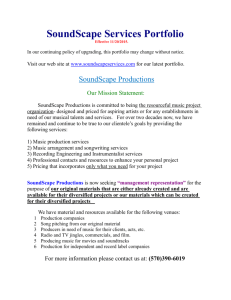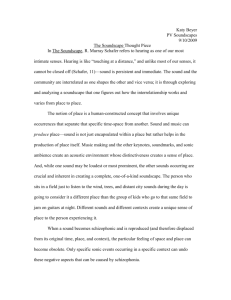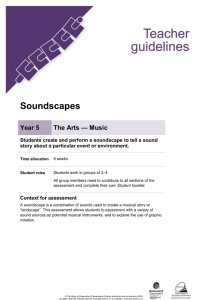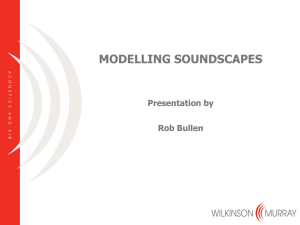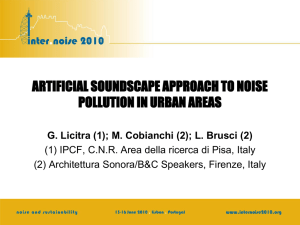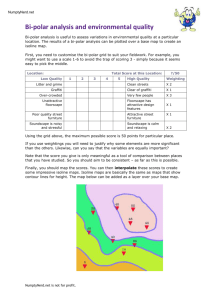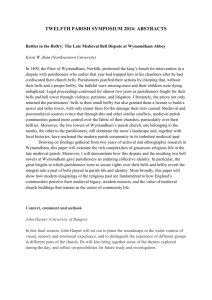Week 2
advertisement
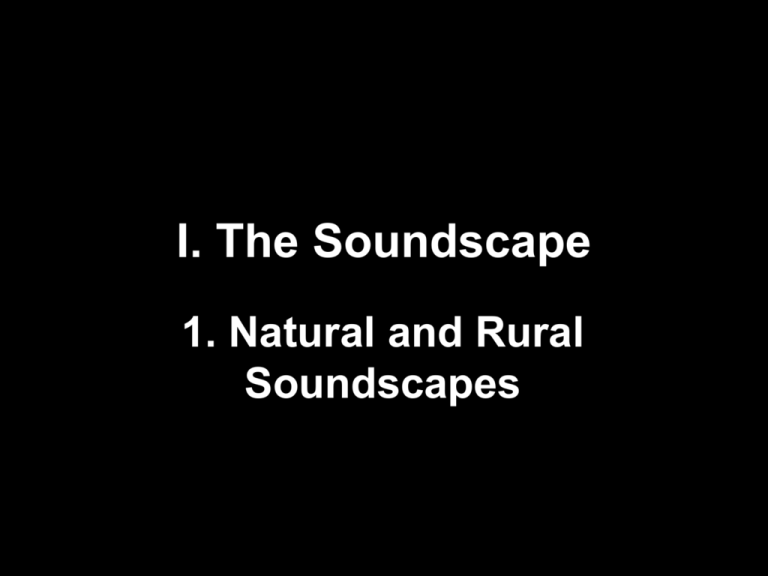
I. The Soundscape 1. Natural and Rural Soundscapes R. Murray Schafer • Born in Sarnia, Ontario, Canada in 1933. • Trained as a composer in England and Canada, has composed over 50 orchestral, chamber, choral and solo vocal works. Also known for his environmental compositions, including Sun Father Sky Mother (1985) for solo voice in a mountain setting, near water and forest; and Harbour Symphony (1983) played with fog horns. • • He has published 27 written works, including The Tuning of the World (The Soundscape) in 1977, revised in 1994. Schafer: • First recipient of the Jules Leger Prize in 1978, first Glenn Gould Prize in 1987. In 2005, he was awarded the Walter Carsen Prize by the Canadian Council for the Arts – one of the top honors for lifetime achievement by a Canadian artist. • Coined the term “soundscape” • Started the World Soundscape Project, (WSP) an educational and research group at Simon Fraser University, during the late 1960s and early 1970s. • NFB film segment with Schafer; Snowforms (1981) The World Soundscape Project group at Simon Fraser University in 1973; left to right: R. M. Schafer, Bruce Davis, Peter Huse, Barry Truax, Howard Broomfield. Vancouver soundscape trailer Soundscape, the book: • The world soundscape is changing – reach an apex of vulgarity (p.3) • Noise pollution – problem – deafness – need to be brought under control • Soundscape studies: middle ground between science, society and the arts • What is the relationship between man and the sounds of his environment and what happens when those sounds change? Soundscape, the book: • Positive and negative approaches; noise abatement vs. ear cleaning • Acoustic design • The world as composition; music as sound • Terminology: keynote, signal, soundmark • Structure of the book: 4 parts and coda Soundwalk: Bernard Field Station (Natural Soundscape) “Perception of scenery is only open to those who have no real part to play in the landscape.” (David Lowenthal) “If I can hear my footsteps as I walk, I know I am in an ecological environment.” (One of Schafer’s students) Part I: Natural and Rural Soundscapes • Natural sounds are unique • Onomatopoeia • Hi-fi and lo-fi soundscapes • Sacred Noise Theory • Church bell and mechanical clock How does Schafer compare the preindustrial human soundscape to the “natural” soundscape? How does he characterize the preindustrial human soundscape? Part II: Industrial and Electronic Soundscapes • Lo-Fi soundscape: noise and power • Sound imperialism • The flat line in sound • Muscle sounds • Schizophonia • Sound walls • Sound technology used as social engineering and control How does Schafer characterize the post-industrial soundscape? What does he propose we do about it? Part III: Analysis • • • • • • Notation Classification Perception Morphology Symbolism Noise Sonic Experience: A Guide to Everyday Sounds • Jean-François Augoyard: philosopher, urban planner, and musicologist; founder of CRESSON-CNRS (The Center for Research on Sonic Space and the Urban EnvironmentNational Scientific Research Center) at the National School of Architecture of Grenoble • Henry Torgue is a sociology, urban planner, and composer; he is a researcher at CRESSON • The book defines 66 of “sonic effects,” designed to analyze the experience of everyday sounds in the context of architecture and urban spaces, with 16 major effects accompanied by essays linking them to psychology, physiology, sociology, architecture, urban studies, communication, cultural studies, music, and aesthetics What is in sonic instrumentarium of urban environment? • Urban sound environment: an object of description / an object of transformation • Qualitative and quantitative tools • The sound object (l’objet sonore) • The soundscape What is in sonic instrumentarium of urban environment? • Urban sound environment: an object of description / an object of transformation • Qualitative and quantitative tools • The sound object (l’objet sonore) • The soundscape The Sonic Effect: • “Effect” from physics, multi-media art, and in the electronic and numerical instrument industry; philosophy (the Platonic theory of the simulacrum) • Uses • Major and minor effects • Fields and domains • categories Part IV: Towards Acoustic Design • Acoustic Ecology - the study of sounds in relationship to life and society • Acoustic Design - "to regard the soundscape of the world as a huge musical composition, unfolding around us ceaselessly. We are simultaneously its audience, its performers and its composers. Which sounds do we want to preserve, encourage, multiply?" (p. 205) • Ear cleaning • Keeping a soundscape diary • Soundwalks • Building an acoustic community • The acoustic designer “If the acoustic designer favors the ear, it is only as an antidote to the visual stress of modern times and in anticipation of the ultimate reintegration of all the senses.” (p. 237) • Preservation of soundmarks • Repairing the soundscape • Utopian soundscapes and acoustic parks • The recovery of positive silence “The essence of sound is felt in both motion and silence, it passes from existent to nonexistent. When there is no sound, it is said that there is no hearing, but that does not mean that hearing has lost its preparedness. Indeed, when there is no sound, hearing is most alert, and when there is sound the hearing nature is least developed.” (Kirpal Singh, quoted on p. 237)
